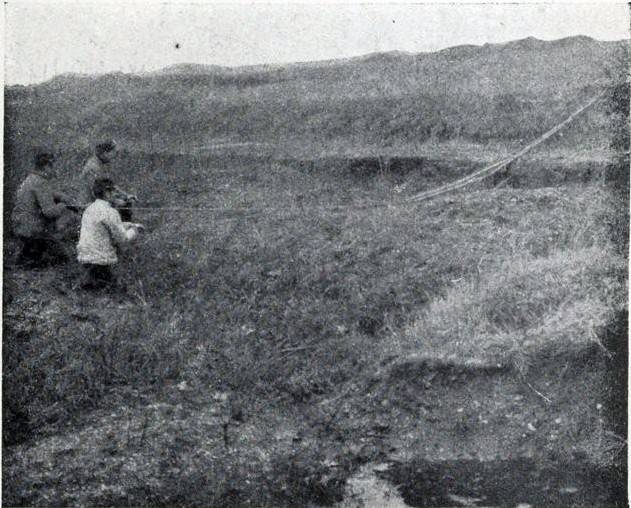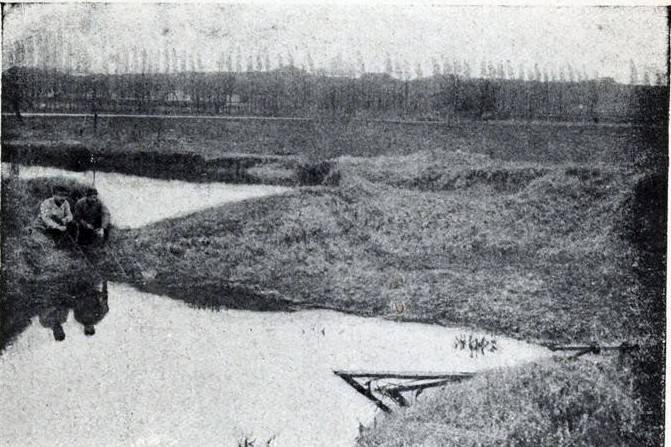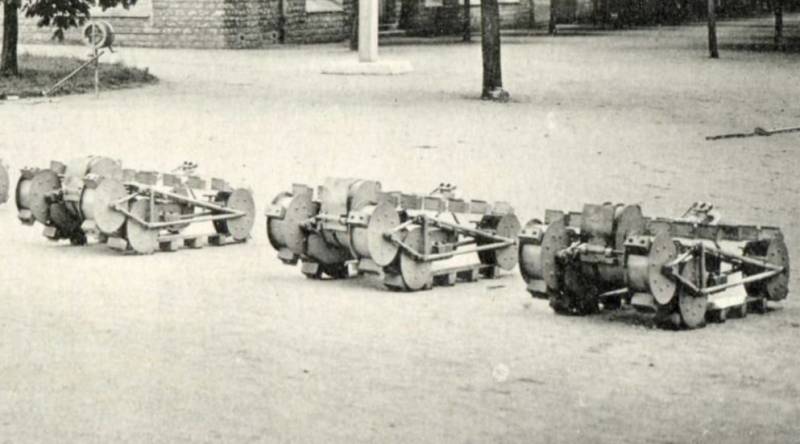Land torpedo Schneider Crocodile (France)
Explosives were a very effective means of dealing with non-explosive barriers, but delivering an engineering charge to a target was a very difficult task. Various ways of solving it were suggested, but they all had certain disadvantages. Almost always, transportation and installation of engineering charge was assigned to people, which led to well-known risks. The way out of this situation could be the mechanization of this process with the help of various technical means, which, however, were not available at that time.
At some point, the idea of a so-called. ground torpedoes - a special compact self-propelled machine, equipped with an uncomplicated powerplant, remote control means and a warhead of sufficient power. The first projects of this kind, brought at least to the test, appeared in France. As a result, the original idea originally carried the French name Torpille Terrestre. Also, such products can be called self-propelled explosive charges.
The first successful land torpedo project was proposed by Schneider. She already had some experience in the development of weapons and military equipment, but the creation of a principled new engineering means was a specific task. Nevertheless, the designers Schneider managed to find the most successful appearance of the product, corresponding to the available technologies and meeting the requirements.
The project is promising Torpille Terrestre received the working designation Schneider Crocodile ("Crocodile"). Subsequently, as the project progressed, additional designations of Type A and Type B appeared. Looking ahead, it can be noted that only the second modification went to the series, marked with the letter “B”, whereas the torpedo “A” was used only during the tests and development of the appearance products.
The formation of the overall look of the new land torpedo did not take long. It was determined that the actual tasks of breaking through the obstacles can be solved with the help of a tracked self-propelled vehicle equipped with an electric power plant. In addition to the necessary electrical equipment, a high-explosive charge of sufficient power must have been present on board the machine. Torpedo was proposed to add the necessary means of remote control as simple as possible design. At the same time, the product should have been distinguished by its minimum size, contributing to a secretive approach to the goal.
In the first months of 1915, the design of the first version of the crocodile torpedo was completed. For this project, designated as Type A, several prototypes were built for testing. Inspection of products not equipped with a real combat unit showed that the proposed engineering ammunition may be of interest to the army. A self-propelled land torpedo, maneuvering at the command of the operator, could indeed approach the enemy barrage and undermine it. However, at this stage, certain problems could be identified to correct which the existing project should be reworked.
According to the test results, Schneider has made certain changes to the existing project, the exact list of which, however, is unknown. Perhaps improvements could affect the power plant, chassis and controls. Some other torpedo devices had to be changed accordingly. The result of the refinement of the existing project was the appearance of the product Crocodile Type B.
In the framework of the second project, the Schneider designers formed the final shape of the self-propelled ammunition, which fully complied with the requirements. After testing, the Crocodile in the “B” version could be put into service and put into series.
The main structural element of the land torpedo was a fairly simple frame, which was proposed to be assembled from tubes of small diameter. The frame had a pair of side units, which served as the basis for the chassis. Each such unit had the form of an irregular quadrangle. Two front tubes of small length were connected to an angular structure connected to a vertical stand, as well as horizontal and inclined parts of large dimensions. The front, lower middle and rear joints of the tubes were equipped with mounts for the axles of the undercarriage elements. Two onboard units of complex shape were connected to each other with the help of several transverse elements.
In the central part of the frame it was proposed to install all the necessary devices. The frame had to carry its own battery with the required characteristics, a pair of electric motors and a warhead of sufficient power. On top of the frame it was not planned to mount any shields. A full-fledged building was also not envisaged. Probably, the open placement of the main devices was associated with the need to minimize the mass of the structure.
The electric power plant was fairly simple. On board the Schneider Crocodile had its own battery associated with a pair of electric motors. With the help of a simple mechanical transmission, the engine was connected to the drive wheel of its own track. To control the operation of the engines offered a wired system. Own cables of the power plant were displayed on the aft device with terminals for fixing control cables. An important feature of the machine was the sealing of on-board electrical systems. Subsequently, this allowed a certain way to increase the combat potential.
It should be noted that some sources describe a different design of the power plant. According to these data, the battery or other source of electricity should have been at the position of the operator or next to it, but not on board the self-propelled machine. In this case, the cables connecting the console and the torpedo were not only a control channel, but also a means of supplying current. However, the version of the use of the external power source does not have worthy evidence.
The project "Crocodile" proposed the use of the simplest chassis. In the front, middle and rear parts of the frame it was proposed to install unified wheel-rollers. The elastic suspension elements were not used, and the axles of the wheels were the frame elements. The front wheel was raised above the ground and served as the lead. Two other skating rinks were below it and were basic skating rinks. Rear while solving the problems of the steering wheel. All wheels-rollers had the same design. They were equipped with a hub on which side-mounted discs of larger diameter were mounted, preventing the track from moving. The latter differed as simple as possible. Its basis was a canvas tape of the required sizes. It was proposed to fasten rectangular wooden bars used as lugs with equal intervals on it.
On board the original French remote-controlled torpedo Torpille Terrestre was supposed to be a combat unit of high-explosive type. In a lightweight case that did not provide sufficient fragmentation, 40 kg of explosive was placed. Type of explosive unknown. To undermine the warhead it was proposed to use an electric fuse with a remote control.

Tests torpedoes. Product removed from operator, only control cables are visible.
For the combat use of land torpedoes, the Crocodile Type A / B had to be answered by the operator, at whose disposal there was an uncomplicated electrical panel. Simple controls allowed electric motors to be turned on or off, as well as to issue a command to undermine the warhead. The simultaneous activation of two engines ensured the forward movement, and for maneuvering it was proposed to disconnect one of the engines. The explosion was carried out by simply applying an electric pulse to the fuse.
The connection of the console and self-propelled ammunition was carried out using three cables. They had to be transported using a separate coil, which should be placed near the position of the operator. Moving to the goal, "Crocodile" had to unwind the wires and pull them along.
According to reports, the Schneider Crocodile Type B combat-ready engineering ammunition had a length of 1,66 m. The width was 0,82 m, the height was only 0,6 m. Relatively low-power electric motors allowed a speed of no more than a few kilometers per hour. Power reserve was also not large, but allowed to destroy barriers within a radius of several hundred meters - in the line of sight.
The method of combat use of land torpedoes was extremely simple. Arriving at the position, the calculation was to deploy the console and the coil with cables, as well as bring the product "Crocodile" to the starting position. Target detection was performed visually, using available optical instruments. Further, the operator could include engines and send self-propelled ammunition to the target. Tracking the position of the machine, necessary to adjust the direction of motion, it was proposed to determine using available means. Bringing a torpedo to the target, the operator could give the command to undermine the warhead. The 40 explosive kg of explosive could make a fairly large passage in any non-explosive barrier. In addition, the goal of a self-propelled system with such a warhead could be any enemy reinforcement that did not have serious protection.
The first few Schneider Crocodile Type B self-propelled land torpedoes were manufactured at the beginning of the summer 1915 of the year and submitted for testing. Testing of experimental products was carried out by the company-developer with the participation of representatives of the military department. The test site was the Maison-Lafite polygon. All necessary tests were carried out in just one day, July 15. In the shortest possible time, the military and representatives of the manufacturing company determined the real characteristics and capabilities of the original weapons.
Self-propelled engineering ammunition could develop a small speed and move a distance limited by the length of the existing cable. With all this, he successfully carried out the operator’s commands and made simple maneuvers. Training the operator was not particularly difficult. The used warhead was supposed to show high enough characteristics suitable for solving assigned tasks.
The electric propulsion system and tracked undercarriage made it possible to move on off-road, both on level and cross-country terrain. In addition, the "Crocodile", as if justifying its name, was able to cross shallow reservoirs along the bottom. Sealed electrical enclosures prevented water from entering and closing. Thus, the land torpedo could work in a variety of conditions, without requiring special relaxation. In particular, she had the opportunity to move through the funnels filled with water.
There were some problems. First of all, the emphasis on electrical systems has led to higher production costs and increased complexity of operation. The absence of any corps, not to mention the booking, had a negative effect on survivability in a combat situation. Similarly, the use of wire control could have an effect on actual results. Only one random fragment could remove a torpedo from combat.
A serious problem was the observation of the movement of the product. Small size hampered the timely detection of a torpedo by the enemy, but at the same time interfered with the operator. In certain conditions, he could lose sight of the car. At the same time, even constant visibility did not facilitate the work of the operator, since he would have to rise above his shelter, risking to become a target for enemy shooters.
Despite all the problems, the new invention of French designers could give the troops certain advantages over the enemy. The Schneider Crocodile Type B product allowed troops to destroy non-explosive barriers relatively quickly and with minimal risk, making the passage for infantry. The existing disadvantages were considered insignificant and acceptable for practical operation. Just a few weeks after conducting short-lived tests, the French military department decided to adopt the new land torpedo.
It is known that the company-developer, having received the order of the army, produced several small batches of new products. Production lasted just under a year. Prior to the beginning of the summer of the 1916, the customer received up to several hundred self-propelled machines with the required additional equipment. Finished products were supplied to various compounds of the French ground forces. In addition, there is information about the supply of such weapons to Great Britain, Belgium, Italy and even Russia. The volumes of such supplies and the results of the use of self-propelled demolition charges by foreign countries are unknown.
According to various sources, starting in the autumn of 1915, the French troops actively used the original land torpedoes to destroy the wire barriers or some enemy fortifications. Perhaps there were some difficulties, but there is reason to believe that, in general, an unusual technique coped with the assigned tasks and helped the troops in the offensive. Naturally, with the level of technology development did not have to hope for 100% reliability.

Torpedo "Crocodile", justifying its name, could overcome shallow reservoirs right along the bottom
In June 1916, the company Schneider ceased production of self-propelled Torpille Terrestre type Crocodile Type B. The order for the release of such weapons was canceled due to progress in other areas. The main task of "Crocodile" was the destruction of non-explosive barriers in front of the enemy positions. At the same time, such a task was solved at the cost of a “life” of a rather complicated and expensive apparatus. After breaking through the barrage, the machine was no longer able to support the troops.
By this time, designers of several enterprises proposed new projects. tanks. Such a technique could also break through the lines of defense, but it did not die near the very first fence. In addition, the tanks had to carry machine gun or cannon weapons, which gave certain advantages. In the light of future combat use, promising tanks with crew and weapons looked more profitable than disposable land torpedoes with a warhead of sufficient power.
The French command, having studied the results and prospects for the development of military equipment, decided to abandon ground torpedoes in favor of full-fledged armored fighting vehicles. The production of Schneider Crocodile was then discontinued. The troops used all the remaining products in stock, after which their operation ceased. In the near future, the first French tanks entered the battlefields. One of them was developed by Schneider, which just a few months ago produced ground torpedoes.
There is reason to believe that all Crocodile Type B products manufactured and delivered to customers were used on the battlefield to defeat certain targets. This assumption is supported by the fact that not a single such land torpedo has survived to our time. An interesting development of a century ago can now be seen only in a few preserved photographs.
As follows from the available data, the Schneider Crocodile Type B self-propelled subversive charge, assigned to the Torpille Terrestre class, coped with the tasks and, given certain limitations and characteristic problems of its time, showed itself well. In addition, he became the first model of the weapon of its kind. Later on, in France and in a number of other countries, attempts were made to create remote-controlled self-propelled engineering torpedoes. Only a part of such samples was brought to mass production and operation, but all of them are of great interest in the context of the development of military equipment.
Based on:
http://pages14-18.mesdiscussions.net/
https://mechanixillustrated.technicacuriosa.com/
http://feldgrau.info/
http://strangernn.livejournal.com/
Everett HR Toscano M. Unmanned Systems of World Wars I and II. MIT Press. 2015.
- Ryabov Kirill
- Pages14-18.mesdiscussions.net, Strangernn.livejournal.com

Information